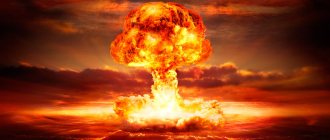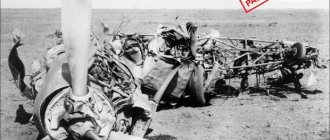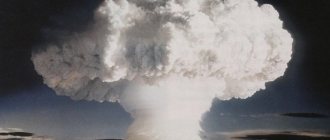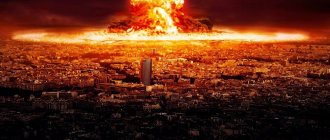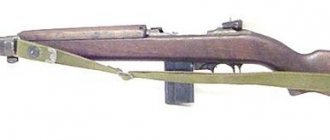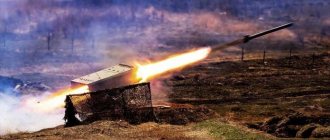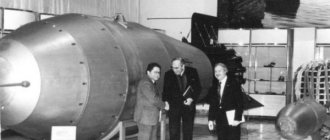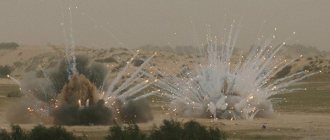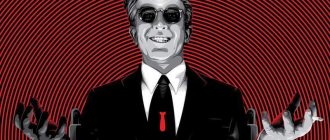Hundreds of thousands of famous and forgotten gunsmiths of antiquity fought in search of the ideal weapon, capable of evaporating an enemy army with one click. From time to time, a trace of these searches can be found in fairy tales that more or less plausibly describe a miracle sword or a bow that hits without missing.
Fortunately, technological progress moved so slowly for a long time that the real embodiment of the devastating weapon remained in dreams and oral stories, and later on the pages of books. The scientific and technological leap of the 19th century provided the conditions for the creation of the main phobia of the 20th century. The nuclear bomb, created and tested under real conditions, revolutionized both military affairs and politics.
History of the creation of weapons
For a long time it was believed that the most powerful weapons could only be created using explosives. The discoveries of scientists working with the smallest particles have provided scientific evidence that enormous energy can be generated with the help of elementary particles. The first in a series of researchers can be called Becquerel, who in 1896 discovered the radioactivity of uranium salts.
Uranium itself has been known since 1786, but at that time no one suspected its radioactivity. The work of scientists at the turn of the 19th and 20th centuries revealed not only special physical properties, but also the possibility of obtaining energy from radioactive substances.
The option of making weapons based on uranium was first described in detail, published and patented by French physicists, the Joliot-Curies in 1939.
Despite its value for weapons, the scientists themselves were strongly opposed to the creation of such a devastating weapon.
Having gone through World War II in the Resistance, in the 1950s the couple (Frederick and Irene), realizing the destructive power of war, advocated for general disarmament. They are supported by Niels Bohr, Albert Einstein and other prominent physicists of the time.
Meanwhile, while the Joliot-Curies were busy with the problem of the Nazis in Paris, on the other side of the planet, in America, the world's first nuclear charge was being developed. Robert Oppenheimer, who led the work, was given the broadest powers and enormous resources. The end of 1941 marked the beginning of the Manhattan Project, which ultimately led to the creation of the first combat nuclear warhead.
In the town of Los Alamos, New Mexico, the first production facilities for weapons-grade uranium were erected. Subsequently, similar nuclear centers appeared throughout the country, for example in Chicago, in Oak Ridge, Tennessee, and research was carried out in California. The best forces of the professors of American universities, as well as physicists who fled from Germany, were thrown into creating the bomb.
In the “Third Reich” itself, work on creating a new type of weapon was launched in a manner characteristic of the Fuhrer.
Since “Besnovaty” was more interested in tanks and planes, and the more the better, he did not see much need for a new miracle bomb.
Accordingly, projects not supported by Hitler moved at a snail's pace at best.
When things started to get hot, and it turned out that the tanks and planes were swallowed up by the Eastern Front, the new miracle weapon received support. But it was too late; in conditions of bombing and constant fear of Soviet tank wedges, it was not possible to create a device with a nuclear component.
The Soviet Union was more attentive to the possibility of creating a new type of destructive weapon. In the pre-war period, physicists collected and consolidated general knowledge about nuclear energy and the possibility of creating nuclear weapons. Intelligence worked intensively throughout the entire period of the creation of the nuclear bomb both in the USSR and in the USA. The war played a significant role in slowing down the pace of development, as huge resources went to the front.
True, Academician Igor Vasilyevich Kurchatov, with his characteristic tenacity, promoted the work of all subordinate departments in this direction. Looking ahead a little, it is he who will be tasked with accelerating the development of weapons in the face of the threat of an American strike on the cities of the USSR. It was he, standing in the gravel of a huge machine of hundreds and thousands of scientists and workers, who would be awarded the honorary title of the father of the Soviet nuclear bomb.
A start
In April 1903, the famous French physicist Paul Langevin's friends gathered in the Paris Garden. The reason was the defense of the dissertation of the young and talented scientist Marie Curie. Among the distinguished guests was the famous English physicist Sir Ernest Rutherford. In the midst of the fun, the lights were turned off. Marie Curie announced to everyone that there would be a surprise. With a solemn look, Pierre Curie brought in a small tube with radium salts, which shone with a green light, causing extraordinary delight among those present. Subsequently, the guests heatedly discussed the future of this phenomenon. Everyone agreed that radium would solve the acute problem of energy shortages. This inspired everyone for new research and further prospects. If they had been told then that laboratory work with radioactive elements would lay the foundation for the terrible weapons of the 20th century, it is not known what their reaction would have been. It was then that the story of the atomic bomb began, killing hundreds of thousands of Japanese civilians.
World's first tests
But let's return to the American nuclear program. By the summer of 1945, American scientists managed to create the world's first nuclear bomb. Any boy who has made himself or bought a powerful firecracker in a store experiences extraordinary torment, wanting to blow it up as quickly as possible. In 1945, hundreds of American soldiers and scientists experienced the same thing.
On June 16, 1945, the first ever nuclear weapons test and one of the most powerful explosions to date took place in the Alamogordo Desert, New Mexico.
Eyewitnesses watching the explosion from the bunker were amazed by the force with which the charge exploded at the top of the 30-meter steel tower. At first, everything was flooded with light, several times stronger than the sun. Then a fireball rose into the sky, turning into a column of smoke that took shape into the famous mushroom.
As soon as the dust settled, researchers and bomb creators rushed to the site of the explosion. They watched the aftermath from lead-encrusted Sherman tanks. What they saw amazed them; no weapon could cause such damage. The sand melted to glass in some places.
Tiny remains of the tower were also found; in a crater of huge diameter, mutilated and crushed structures clearly illustrated the destructive power.
Trinity (21 kilotons)
The Americans were the first in the world to test this bomb, called the “Thing.” Its power of 21 kilotons allowed it to take eighth place in our ranking of nuclear explosions. When the “thing” exploded, the nuclear mushroom rose 11 kilometers. The destruction caused by the test stunned scientists.
At the site of the explosion, a new mineral was obtained for the first time - trinitite, formed as a result of the fusion of quartz and feldspar.
Damaging factors
This explosion provided the first information about the power of the new weapon, about what it could use to destroy the enemy. These are several factors:
- light radiation, flash, capable of blinding even protected organs of vision;
- shock wave, a dense stream of air moving from the center, destroying most buildings;
- an electromagnetic pulse that disables most equipment and does not allow the use of communications for the first time after the explosion;
- penetrating radiation, the most dangerous factor for those who have taken refuge from other damaging factors, is divided into alpha-beta-gamma irradiation;
- radioactive contamination that can negatively affect health and life for tens or even hundreds of years.
The further use of nuclear weapons, including in combat, showed all the peculiarities of their impact on living organisms and nature. August 6, 1945 was the last day for tens of thousands of residents of the small city of Hiroshima, then known for several important military installations.
The outcome of the war in the Pacific was a foregone conclusion, but the Pentagon believed that the operation on the Japanese archipelago would cost more than a million lives of US Marines. It was decided to kill several birds with one stone, take Japan out of the war, saving on the landing operation, test a new weapon and announce it to the whole world, and, above all, to the USSR.
At one o'clock in the morning, the plane carrying the "Baby" nuclear bomb took off on a mission.
The bomb, dropped over the city, exploded at an altitude of approximately 600 meters at 8.15 am. All buildings located at a distance of 800 meters from the epicenter were destroyed. The walls of only a few buildings, designed to withstand a magnitude 9 earthquake, survived.
Of every ten people who were within a radius of 600 meters at the time of the bomb explosion, only one could survive. The light radiation turned people into coal, leaving shadow marks on the stone, a dark imprint of the place where the person was. The ensuing blast wave was so strong that it could break glass at a distance of 19 kilometers from the explosion site.
One teenager was knocked out of the house through a window by a dense stream of air; upon landing, the guy saw the walls of the house folding like cards. The blast wave was followed by a fire tornado, destroying those few residents who survived the explosion and did not have time to leave the fire zone. Those at a distance from the explosion began to experience severe malaise, the cause of which was initially unclear to doctors.
Much later, a few weeks later, the term “radiation poisoning” was announced, now known as radiation sickness.
More than 280 thousand people became victims of just one bomb, both directly from the explosion and from subsequent illnesses.
The bombing of Japan with nuclear weapons did not end there. According to the plan, only four to six cities were to be hit, but weather conditions only allowed Nagasaki to be hit. In this city, more than 150 thousand people became victims of the Fat Man bomb.
Promises by the American government to carry out such attacks until Japan surrendered led to an armistice and then to the signing of an agreement that ended World War II. But for nuclear weapons this was just the beginning.
Japan will not capitulate
By the time of the final and successful testing of the atomic bomb, Soviet troops and allies had finally defeated Nazi Germany. However, there was one state that promised to fight to the end for dominance in the Pacific Ocean. From mid-April to mid-July 1945, the Japanese army repeatedly carried out air strikes against allied forces, thereby inflicting heavy losses on the US army. At the end of July 1945, the militaristic Japanese government rejected the Allied demand for surrender under the Potsdam Declaration. It stated, in particular, that in case of disobedience, the Japanese army would face rapid and complete destruction.
The most powerful bomb in the world
The post-war period was marked by the confrontation between the USSR bloc and its allies with the USA and NATO. In the 1940s, the Americans seriously considered the possibility of striking the Soviet Union. To contain the former ally, work on creating a bomb had to be accelerated, and already in 1949, on August 29, the US monopoly in nuclear weapons was ended. During the arms race, two nuclear tests deserve the most attention.
Bikini Atoll, known primarily for frivolous swimsuits, literally made a splash throughout the world in 1954 due to the testing of a specially powerful nuclear charge.
The Americans, having decided to test a new design of atomic weapons, did not calculate the charge. As a result, the explosion was 2.5 times more powerful than planned. Residents of nearby islands, as well as the ubiquitous Japanese fishermen, were under attack.
But it was not the most powerful American bomb. In 1960, the B41 nuclear bomb was put into service, but it never underwent full testing due to its power. The force of the charge was calculated theoretically, for fear of exploding such a dangerous weapon at the test site.
The Soviet Union, which loved to be first in everything, tested the Tsar Bomba in 1961, otherwise nicknamed “Kuzka’s Mother.”
Responding to America's nuclear blackmail, Soviet scientists created the most powerful bomb in the world. Tested on Novaya Zemlya, it left its mark in almost all corners of the globe. According to recollections, a slight earthquake was felt in the most remote corners at the time of the explosion.
The blast wave, of course, having lost all its destructive power, was able to circle the Earth. To date, this is the most powerful nuclear bomb in the world created and tested by mankind. Of course, if his hands were free, Kim Jong-un's nuclear bomb would be more powerful, but he does not have New Earth to test it.
The President agrees
The American government kept its word and began a targeted bombing of Japanese military positions. Air strikes did not bring the desired result, and US President Harry Truman decides to invade Japanese territory by American troops. However, the military command dissuades its president from such a decision, citing the fact that an American invasion would entail a large number of casualties.
At the suggestion of Henry Lewis Stimson and Dwight David Eisenhower, it was decided to use a more effective way to end the war. A big supporter of the atomic bomb, US Presidential Secretary James Francis Byrnes, believed that the bombing of Japanese territories would finally end the war and put the United States in a dominant position, which would have a positive impact on the further course of events in the post-war world. Thus, US President Harry Truman was convinced that this was the only correct option.
Atomic bomb device
Let's consider a very primitive, purely for understanding, device of an atomic bomb. There are many classes of atomic bombs, but let’s consider three main ones:
- uranium, based on uranium 235, first exploded over Hiroshima;
- plutonium, based on plutonium 239, first exploded over Nagasaki;
- thermonuclear, sometimes called hydrogen, based on heavy water with deuterium and tritium, fortunately not used against the population.
The first two bombs are based on the effect of heavy nuclei fissioning into smaller ones through an uncontrolled nuclear reaction, releasing huge amounts of energy. The third is based on the fusion of hydrogen nuclei (or rather its isotopes of deuterium and tritium) with the formation of helium, which is heavier in relation to hydrogen. For the same bomb weight, the destructive potential of a hydrogen bomb is 20 times greater.
If for uranium and plutonium it is enough to bring together a mass greater than the critical one (at which a chain reaction begins), then for hydrogen this is not enough.
To reliably connect several pieces of uranium into one, a cannon effect is used in which smaller pieces of uranium are shot into larger ones. Gunpowder can also be used, but for reliability, low-power explosives are used.
In a plutonium bomb, to create the necessary conditions for a chain reaction, explosives are placed around ingots containing plutonium. Due to the cumulative effect, as well as the neutron initiator located at the very center (beryllium with several milligrams of polonium), the necessary conditions are achieved.
The hydrogen bomb is similar in design to the F1 grenade.
It has a main charge, which cannot explode on its own, and a fuse. To create conditions for the fusion of deuterium and tritium nuclei, we need unimaginable pressures and temperatures at at least one point. Next, a chain reaction will occur.
To create such parameters, the bomb includes a conventional, but low-power, nuclear charge, which is the fuse. Its detonation creates the conditions for the start of a thermonuclear reaction.
To estimate the power of an atomic bomb, the so-called “TNT equivalent” is used. An explosion is a release of energy, the most famous explosive in the world is TNT (TNT - trinitrotoluene), and all new types of explosives are equated to it. Bomb "Baby" - 13 kilotons of TNT. That is, equivalent to 13,000 tons of TNT.
Bomb "Fat Man" - 21 kilotons, "Tsar Bomba" - 58 megatons of TNT. It’s scary to think of 58 million tons of explosives concentrated in a mass of 26.5 tons, that’s how much weight this bomb has.
The danger of nuclear war and nuclear disasters
Appearing in the midst of the worst war of the twentieth century, nuclear weapons became the greatest danger to humanity. Immediately after World War II, the Cold War began, which several times almost escalated into a full-fledged nuclear conflict. The threat of the use of nuclear bombs and missiles by at least one side began to be discussed back in the 1950s.
Everyone understood and understands that there can be no winners in this war.
To contain it, efforts have been and are being made by many scientists and politicians. The University of Chicago, using the input of visiting nuclear scientists, including Nobel laureates, sets the Doomsday Clock a few minutes before midnight. Midnight signifies a nuclear cataclysm, the beginning of a new World War and the destruction of the old world. Over the years, the clock hands fluctuated from 17 to 2 minutes to midnight.
There are also several known major accidents that occurred at nuclear power plants. These disasters have an indirect relation to weapons; nuclear power plants are still different from nuclear bombs, but they perfectly demonstrate the results of using the atom for military purposes. The largest of them:
- 1957, Kyshtym accident, due to a failure in the storage system, an explosion occurred near Kyshtym;
- 1957, Britain, in the north-west of England, security checks were not carried out;
- 1979, USA, due to an untimely detected leak, an explosion and release from a nuclear power plant occurred;
- 1986, tragedy in Chernobyl, explosion of the 4th power unit;
- 2011, accident at the Fukushima station, Japan.
Each of these tragedies left a heavy mark on the fate of hundreds of thousands of people and turned entire areas into non-residential zones with special control.
There were incidents that almost cost the start of a nuclear disaster. Soviet nuclear submarines have repeatedly had reactor-related accidents on board. The Americans dropped a Superfortress bomber with two Mark 39 nuclear bombs on board, with a yield of 3.8 megatons. But the activated “safety system” did not allow the charges to detonate and a disaster was avoided.
Playing ahead
On December 17, 1938, the German scientist Otto Gann obtained irrefutable evidence of the decay of uranium into smaller elementary particles. Essentially, he managed to split the atom. In the scientific world, this was regarded as a new milestone in the history of mankind. Otto Gann did not share the political views of the Third Reich. Therefore, in the same year, 1938, the scientist was forced to move to Stockholm, where, together with Friedrich Strassmann, he continued his scientific research. Fearing that Nazi Germany will be the first to receive terrible weapons, he writes a letter to the President of America warning about this. The news of a possible advance greatly alarmed the US government. The Americans began to act quickly and decisively.
Nuclear weapons past and present
Today it is clear to anyone that a nuclear war will destroy modern humanity. Meanwhile, the desire to possess nuclear weapons and enter the nuclear club, or rather, burst into it by knocking down the door, still excites the minds of some state leaders.
India and Pakistan created nuclear weapons without permission, and the Israelis are hiding the presence of a bomb.
For some, owning a nuclear bomb is a way to prove their importance on the international stage. For others, it is a guarantee of non-interference by winged democracy or other external factors. But the main thing is that these reserves do not go into business, for which they were really created.
